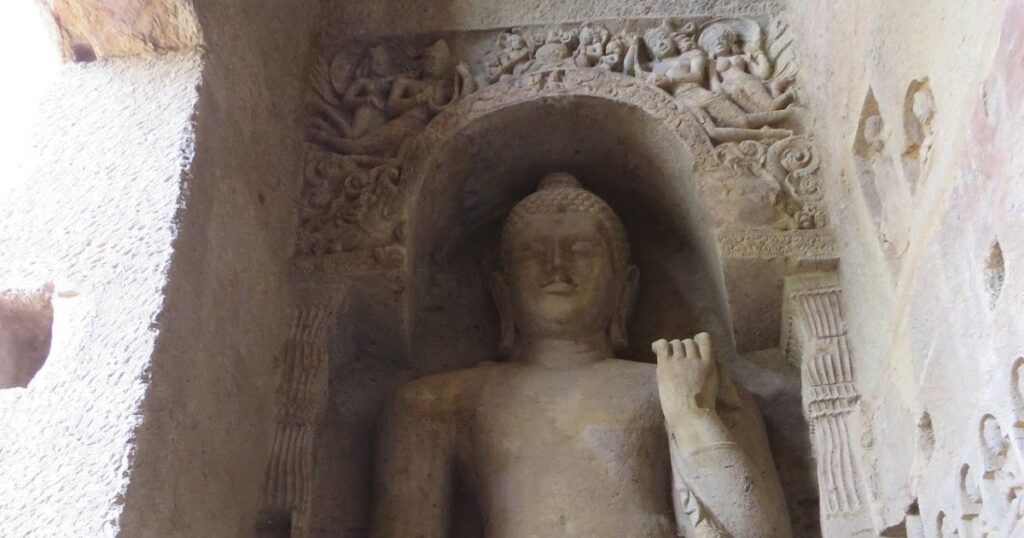This is the 11th installment in my series on the Kanheri Caves. In earlier articles, I explored Cave No. 1 and Cave No. 2 in detail. In the last two episodes, I introduced Cave No. 3, discussing its entrance, sculptures, and the two massive pillars at the inner entrance. As mentioned before, this cave features a well-crafted forecourt with a flight of steps leading to a rectangular verandah and an apsidal Chaitya at the rear. In this episode, I focus on two large Buddha sculptures in the verandah. I will cover the remaining sculptures of the verandah, Chaitya and inscriptions in the forth-coming episodes.
Cave No. 3 faces west. Within its rectangular verandah, two towering Buddha sculptures—each 7 meters high—stand on the north and south-facing walls.
The South-Facing Buddha
Positioned to the viewer’s left upon entering the verandah, this Buddha is depicted in a standing posture (Samapāda-sthānaka), with both feet firmly placed parallel to each other. The body exhibits a subtle contrapposto stance, with a slight shift in weight.
His right hand is extended downward in Varada Mudrā (the gesture of granting blessings), while the left hand is raised at chest level in Vyākhyāna Mudrā (the gesture of teaching). He wears a thin, clinging monastic robe (Sanghati) that drapes over his left shoulder, leaving the right shoulder exposed. The fabric’s delicate folds follow the body’s contours, revealing the chest and abdomen, and a distinctive wavy border cascades down the left side. The robe’s fine craftsmanship creates an illusion of transparency.
Buddha’s face exudes calmness, with downcast eyes, curved eyebrows, full lips, and a slightly elongated nose. He has elongated earlobes (Karna Patra), a well-defined Ushnīsha (cranial protuberance), and a faint Urṇā (forehead mark).
Above the Buddha, an arched torana (gateway) serves both decorative and symbolic functions. This semi-circular arch, supported by intricately carved vertical pilasters, acts as a canopy reinforcing his divine status. At its apex, two pairs of celestial beings—possibly Gandharvas or Devas—are seated in Anjali Mudrā, paying homage to a central kalasha (sacred pot). Behind them, two larger pairs of Vidyadharas (heavenly beings) hover, holding garlands. At the center of the torana, a small figure of Amitabha Buddha sits in Padmasana with hands in Dhyana Mudrā. The torana emerges from the sculpted mouths of mythical Makara creatures.
Beside the standing Buddha, within a recessed niche, a smaller female figure is carved in high relief. Positioned on the Buddha’s true left (viewer’s right), she stands in a relaxed pose, with one leg slightly bent. Her right hand is elegantly raised, possibly in Katakahasta Mudrā, while her left hand rests on her hip or drapes over her garment. Despite weathering, her face retains a serene expression with a slight smile. She has elongated eyes and wears an elaborate headdress, suggesting she may be a celestial attendant (Apsara) or a Bodhisattva-associated deity.
Her attire consists of a draped lower garment (Antariya), secured with a waistband, and a tight-fitting blouse or bare upper body. She is adorned with a beaded necklace, armlets (Bajuband) on both arms, bangles on both wrists and large earrings or ear ornaments.
Her delicate features, intricate ornamentation, and poised stance suggest she may represent an Apsara or Yakshi (fertility deity), possibly the Yakshini named Hariti.
The North-Facing Buddha
On the opposite end of the verandah stands another colossal Buddha figure, facing north. While similar to the previous statue, it exhibits notable differences. Like the first, he stands in Sambhanga posture (a perfectly upright stance) with a slightly curved body. His right hand is extended in Varada Mudrā, but his left hand differs—it is raised and holds the edge of his monastic robe (Sanghati). The drapery, flowing over his left shoulder, reveals the contours of his body, with visible pleats along the edges demonstrating refined craftsmanship. His expression remains serene and meditative, with elongated earlobes signifying renunciation.
The torana above this Buddha is simpler. It also emerges from Makara mouths, but unlike the south-facing torana, it lacks a central Amitabha Buddha. Additionally, only two Vidyadharas are seen above, holding garlands.
These grand sculptures, along with their intricate architectural elements, showcase the artistic and spiritual depth of Kanheri Cave No. 3, reflecting the region’s rich Buddhist heritage.
Happy travelling.
This is Part 11 of the series of articles on Kanheri Caves. If you are interested to read the earlier parts of the series, click the links below.
Part 1
Part 2
Part 3
Part 4
Part 5
Part 6
Part 7
Part 8
Part 9
Part 10


.JPG)
.JPG)
.JPG)